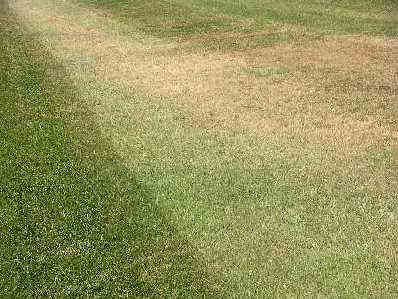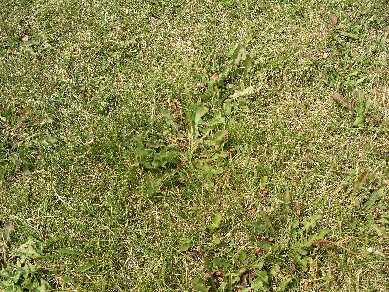Dormant lawn care
Learn why lawns go dormant in summer and steps to keep the lawn healthy until it greens up again.
Introduction
With dry weather, people start wondering what is going on with their brown lawn (Figure 1). The first thing to realize is that when lawns go brown in the summer due to lack of rain, they are not dead, they are just dormant. The grass plants may appear dead to the naked eye, but deep inside the plant there is a small area (called the crown) that is still alive. Once this crown gets moisture again, it will come to life and the turf will green up in 10–14 days.

Dormancy and damage
We know that turf can remain dormant for up to six weeks without any adverse effects. There may be some turf loss if the dry period continues much longer. For every week after the six-week mark, expect a loss of about 25% of the turf. One thing that is important when lawns are dormant is to try to keep traffic off them.
If the lawns receive a lot of traffic while in a dormant state, there will be irreparable damage.
The other factor that could affect how well your lawn will come back is whether there are hairy chinch bugs feeding on your lawn. Most summers, hairy chinch bug feeding is noticed in late July. It is evident because there will be small sunken patches of brown turf in amongst the green lawn. During dry years, the lawns are brown and dormant, and the chinch bug damage is not very evident. If the rains come in August or September and your lawn does not green up in 10–14 days, there is a good chance that you have chinch bug damage. If your lawn is damaged, either by chinch bugs or drought, overseed the area in the fall to help it recover.
For a detailed description of fall overseeding, see the OMAFRA fact sheet Preparing your lawn for winter.
Weed invasion
Another result of having your lawn dormant for several weeks in the summer is broadleaf weed invasion (Figure 2). When lawns are dormant, they are not thick, lush and green. If the weed seeds that are lurking in the top of the soil in your lawn get some light and some moisture, they will germinate and get established in your dormant lawn.

Watering restrictions
During the summer, some municipalities in Ontario issue total lawn watering bans with high fines for people who ignore the ban. If you are in an area where there is no lawn watering ban, here are a few tips to keep turf alive and conserve water at the same time.
- Water turf once a week with about 2.5 cm of water. This may not keep the turf from going dormant, but it will ensure that it survives this dry period. Use an empty can to help you know when you have put on 2.5 cm.
- If possible, cycle irrigation to allow water penetration and avoid water runoff. Dry soils may not be able to absorb 2.5 cm of water in one watering.
- Water turf in the early morning. This helps reduce water loss to evaporation and also helps minimize the development of diseases.
- Never set sprinklers to water pavement, driveways or sidewalks, as this wastes water.
This fact sheet was written by Pam Charbonneau, turfgrass specialist, OMAFRA, Guelph.